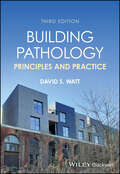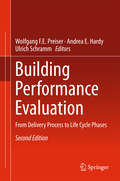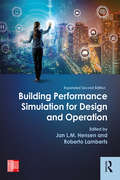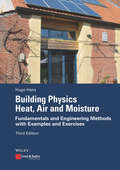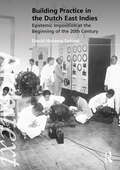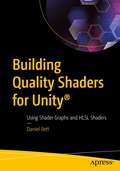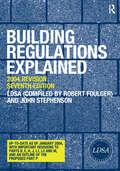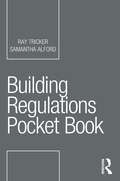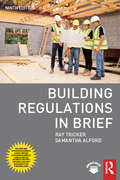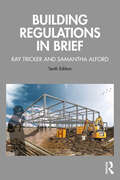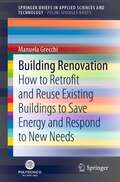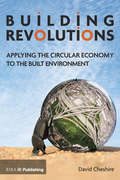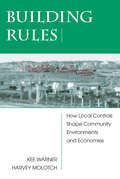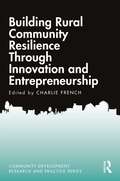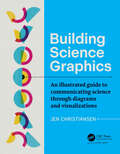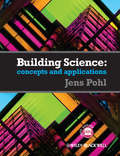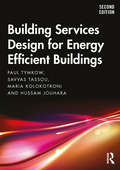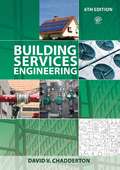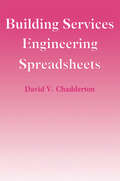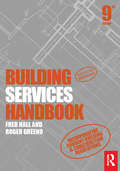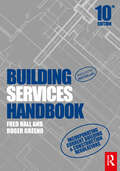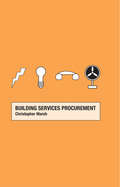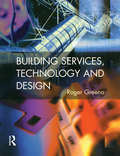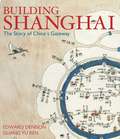- Table View
- List View
Building Pathology: Principles and Practice
by David S. WattWell-illustrated introduction to building pathology, bridging the gap between building surveying and the detailed understanding of building defects, their prognosis and remediation Building Pathology introduces the concept of building pathology and aims to give the reader a greater awareness and understanding of buildings and their users, to assist in defect diagnosis and the design and implementation of specific and appropriate remedial measures. By focusing on the process, rather than specific solutions, the book helps the reader to use the information in their practice in a wide variety of situations. The new third edition features new case studies which have been integrated into the text. Written by a highly qualified author with significant experience in the field, the third edition of Building Pathology contains information on: Building performance, covering environmental factors, user requirements, building structures and materialsDefects, damage, and decay, covering atmospheric and climatic action, excess moisture, chemical, physical, and biological action, movement, fire and human factorsSurvey and assessment, covering building inspections and surveys, how to prioritize defects, unoccupied buildings and sites, and redundant and ruined buildingsRemediation in practice, covering real-world examples With comprehensive coverage of the subject, Building Pathology is an essential learning resource for students of building surveying, as well as professional architects, building surveyors, property managers and those working in heritage disciplines.
Building Performance Evaluation: From Delivery Process to Life Cycle Phases
by Wolfgang F.E. Preiser Andrea E. Hardy Ulrich SchrammThe main aim of this book is to present an intriguing retrospective of Building Performance Evaluation (BPE) as it evolved from Post-Occupancy Evaluation (POE) over the past 25 years. On one hand, this is done by updating original authors' chapter content of Building Evaluation, the first edition published in 1989. That, in turn, is augmented by an orientation toward current and future practice on the other, including new authors who are engaged in ongoing, cutting edge projects. Therefore, individual, methodology oriented chapters covering the fundamental principles of POE and BPE go along with major thematic chapters, topics of which like sustainability or integration of new technologies are addressed in a diversity of case studies from around the globe. Research, methodologies, and framework of POEs continue to evolve. POEs are one step, on the larger scale of BPE, in understanding how buildings function after they are occupied. This resource helps a rchitects, building owners, and facility managers understand the implications and reactions to the facilities that they designed, built and/or commissioned. By considering the whole process from conception to future uses of the building, there can be a more holistic approach to the planning, programming, design, construction, occupancy, and future adaptability of the structure. This book is dedicated to first editor Wolfgang F. E. Preiser who passed away during the process of editing and reviewing chapters of this volume.
Building Performance Simulation for Design and Operation
by Jan L.M. Hensen Roberto LambertsWhen used appropriately building performance simulation has the potential to reduce the environmental impact of the built environment, to improve indoor quality and productivity, as well as facilitating future innovation and technological progress in construction. Since publication of the first edition of Building Performance Simulation for Design and Operation, the discussion has shifted from a focus on software features to a new agenda, which centres on the effectiveness of building performance simulation in building life cycle processes. This new edition provides a unique and comprehensive overview of building performance simulation for the complete building life-cycle from conception to demolition, and from a single building to district level. It contains new chapters on building information modelling, occupant behaviour modelling, urban physics modelling, urban building energy modelling, and renewable energy systems modelling. This new edition keeps the same chapter structure throughout including learning objectives, chapter summaries and assignments. Moreover, the book: • Provides unique insights into the techniques of building performance modelling and simulation and their application to performance based design and operation of buildings and the systems which service them. • Provides readers with the essential concepts of computational support of performance based design and operation. • Provides examples of how to use building simulation techniques for practical design, management and operation, their limitations and future direction. It is primarily intended for building and systems designers and operators, post-graduate architectural, environmental or mechanical engineering students
Building Physics - Heat, Air and Moisture: Fundamentals and Engineering Methods with Examples and Exercises
by Hugo S. HensBad experiences with construction quality, the energy crises of 1973 and 1979, complaints about "sick buildings", thermal, acoustical, visual and olfactory discomfort, the need for good air quality, the move towards more sustainability - all these have accelerated the development of a field that, for a long time, was hardly more than an academic exercise: building physics (in English speaking countries sometimes referred to as building science). The discipline embraces domains such as heat and mass transfer, building acoustics, lighting, indoor environmental quality and energy efficiency. In some countries, fire safety is also included. Through the application of physical knowledge and its combination with information coming from other disciplines, the field helps to understand the physical phenomena governing building parts, building envelope, whole buildings and built environment performance, although for the last the wording "urban physics" is used. Today, building physics has become a key player on the road to a performance based building design. The book deals with the description, analysis and modeling of heat, air and moisture transport in building assemblies and whole buildings with main emphasis on the building engineering applications, including examples. The physical transport processes determine the performance of the building envelope and may influence the serviceability of the structure and the whole building. Compared to the second edition, in this third edition the text has partially been revised and extended.
Building Practice in the Dutch East Indies: Epistemic Imposition at the Beginning of the 20th Century (Architext)
by David Hutama SetiadiThis book reveals the ‘epistemic imposition’ of architectural ideas and practices by colonists from the Netherlands in the Dutch East Indies from the late-19th century onwards, exploring the ways in which this came to shape the profession up to the present day in what is now known as Indonesia. The author investigates the scope of these interventions by Dutch colonial agents in relation to existing Javanese building practices, pursuing two main lines of enquiry. The first is to examine the methods of dissemination of Dutch-taught technical knowledge and skills across the Dutch East Indies. The second is to scrutinise the effects of this dissemination upon the formation of architectural knowledge and practice within the colony. Throughout this book, the argument is made that what took place in architecture in the Dutch East Indies involved a process of disseminating building knowledge as a form of ‘epistemic imposition’ upon the indigenous citizens of the colony – in other words, as an effective instrument of Dutch colonial power. This book will be of interest to architecture academics and students interested in developing a broader global understanding of architecture, especially those interested in decolonising the teaching of architectural history and theory.
Building Quality Shaders for Unity®: Using Shader Graphs and HLSL Shaders
by Daniel IlettUnderstand what shaders are and what they’re used for: Shaders are often seen as mystical and difficult to develop, even by skilled programmers, artists, and developers from other game design disciplines. This book dispels that idea by building up your shader knowledge in stages, starting with fundamental shader mathematics and how shader development mindset differs from other types of art and programming, and slowly delves into topics such as vertex and fragment shaders, lighting, depth-based effects, texture mapping, and Shader Graph.This book presents each of these topics with a comprehensive breakdown, the required theory, and some practical applications for the techniques learned during each chapter. The HLSL (High Level Shading Language) code and Shader Graphs will be provided for each relevant section, as well as plenty of screenshots.By the end of this book, you will have a good understanding of the shader development pipeline and you will be fully equipped to start making your own aesthetic and performant shader effects for your own games!You Will Learn To• Use shaders across Unity’s rendering pipelines• Write shaders and modify their behavior with C# scripting• Use Shader Graph for codeless development• Understand the important math behind shaders, particularly space transformations• Profile the performance of shaders to identify optimization targetsWho Is This Book ForThis book is intended for beginners to shader development, or readers who may want to make the jump from shader code to Shader Graph. It will also include a section on shader examples for those who already know the fundamentals of shaders and are looking for specific use cases.
Building Regulations Explained
by John Stephenson London District Surveyors AssociationAlmost all buildings erected or altered in England and Wales must satisfy the requirements of the building regulations. This essential reference has been revised in line with new legislation up to January 2004, including important revisions to Parts B, E, H, J, L1, L2, and M and an outline of the proposed Part P.Each chapter explains in clear terms the appropriate regulation and any other legislation, before explaining the approved document. The Appeals and Determinations have been repositioned at the end of each chapter. Publications lists and relevant sources of information are also included, together with annexes devoted to legislation relevant to the construction industry, determinations made by the Secretary of State, and sample check lists.This highly illustrated and practical approach to the subject makes this the indispensable, one-stop reference guide for professionals and students.
Building Regulations Pocket Book (Routledge Pocket Books)
by Ray Tricker Samantha AlfordThis handy guide provides you with all the information you need to comply with the UK Building Regulations and Approved Documents. On site, in the van, in the office, wherever you are, this is the book you’ll refer to time and time again to double check the regulations on your current job. The Building Regulations Pocket Book is the must have reliable and portable guide to compliance with the Building Regulations. Part 1 provides an overview of the Building Act Part 2 offers a handy guide to the dos and don’ts of gaining the Local Council’s approval for Planning Permission and Building Regulations Approval Part 3 presents an overview of the requirements of the Approved Documents associated with the Building Regulations Part 4 is an easy to read explanation of the essential requirements of the Building Regulations that any architect, builder or DIYer needs to know to keep their work safe and compliant on both domestic or non-domestic jobs This book is essential reading for all building contractors and sub-contractors, site engineers, building engineers, building control officers, building surveyors, architects, construction site managers and DIYers. Homeowners will also find it useful to understand what they are responsible for when they have work done on their home (ignorance of the regulations is no defence when it comes to compliance!).
Building Regulations in Brief
by Ray Tricker Samantha AlfordThis ninth edition of the most popular and trusted guide reflects all the latest amendments to the Building Regulations, planning permission and the Approved Documents in England and Wales. This includes coverage of the new Approved Document Q on security, and a second part to Approved Document M which divides the regulations for 'dwellings' and 'buildings other than dwellings'. A new chapter has been added to incorporate these changes and to make the book more user friendly. Giving practical information throughout on how to work with (and within) the Regulations, this book enables compliance in the simplest and most cost-effective manner possible. The no-nonsense approach of Building Regulations in Brief cuts through any confusion and explains the meaning of the Regulations. Consequently, it has become a favourite for anyone in the building industry or studying, as well as those planning to have work carried out on their home.
Building Regulations in Brief
by Ray Tricker Samantha AlfordThis tenth edition of the most popular and trusted guide reflects all the latest amendments to the Building Regulations, planning permission and the Approved Documents in England and Wales. This includes coverage of the recent changes to use classes, updated sections on planning permission, permitted development and application fees. We have included the revisions to Approved Document B (as a result of the Hackitt Review), as well as the latest changes to Approved Documents F and L, and the new documents O (overheating) and S (electric vehicle charging points), which come into effect in June 2022. Giving practical information throughout on how to work with (and within) the Regulations, this book enables compliance in the simplest and most cost-effective manner possible. The no-nonsense approach of Building Regulations in Brief cuts through any confusion and explains the meaning of the Regulations. Consequently, it has become a favourite for anyone working in or studying the building industry, as well as those planning to have work carried out on their home. It is essential reading for all building contractors and subcontractors, site engineers, building engineers, building control officers, building surveyors, architects, construction site managers and DIYers.
Building Renovation: How to Retrofit and Reuse Existing Buildings to Save Energy and Respond to New Needs (SpringerBriefs in Applied Sciences and Technology)
by Manuela GrecchiThis book reviews the building renovation process by systematizing the phases of analysis and prior knowledge through a project that not only considers energy savings but also thoroughly examines complex issues, such as defining the correct new functions and answers to new needs. The urgency of climate change and the many problems associated with the excessive use of energy are forcing a reorganization of the renovation process with an interest in reusing existing buildings with a more sustainable approach. The adaptive transformation of old buildings has become a dominant theme in many urban renewal projects. It must necessarily include strategies for energy efficiency, reduced pollutant emissions, improved environmental performance, economic sustainability and cultural identity. The examples selected are intended to provide evidence of good practices in the review and transformation of old buildings.
Building Revolutions: Applying the Circular Economy to the Built Environment
by David CheshireThe construction industry operates within a linear economy of make, use, dispose. Buildings are stripped out and torn down with astonishing regularity while new buildings are constructed from hard-won virgin materials. But raw materials are becoming scarce, and the demands for them are exploiting fragile ecosystems, even as the global demand for resources continues to rise. Policy makers and organisations are beginning to look for a more regenerative, circular economy model. The construction industry demands over half the world’s extracted materials and generates around a third of the total waste generated in the EU, making it a prime candidate for applying the circular economy. Yet there has been little focus on how construction industry professionals and their clients can contribute towards the movement. Drawing on illustrative methods and examples, Building Revolutions explains how the principles of a circular economy can be applied to the built environment where resources are kept in use and their value retained.
Building Rules: How Local Controls Shape Community Environments And Economies
by Kee WarnerBased on a systematic comparative study of urban areas in Southern California, this book provides a much-needed examination of the true impacts of local development controls, including the ways that they have and have not made a difference. Urban and suburban growth is a burning local issue for communities across the United States and many other parts of the world. Concerns include protecting habitats, high costs of infrastructure, social inequalities, traffic congestion and more intangible worries about quality of life. Citizens pressure public officials to intensify development regulations, flying in the face of local growth machines. Builders and growth boosters oppose regulation as unfair and bad for local economies. Based on a systematic comparative study of urban areas in Southern California, this book provides a much-needed examination of the true impacts of local development controls, including the ways that they have and have not made a difference. The authors draw general implications for communities elsewhere and how to better understand theories of growth and urban governance.
Building Rural Community Resilience Through Innovation and Entrepreneurship (Community Development Research and Practice Series)
by Charlie FrenchDrawing from empirical analyses, case studies, and a synthesis of best practices, this book explores how innovation manifests itself in rural places and how it contributes to entrepreneurial development and resilience. Innovation in rural places may come about as a result of new forms of collaboration; policies that leverage rural assets and address critical service or product gaps; novel strategies for accessing financial capital; infusion of arts into aspects of community life; and cultivation of networks that bridge entrepreneurs, organizations, and institutions. The chapters illustrate how a number of innovation-related characteristics relate to economic vibrancy in rural places such as a strong connection to the arts, adaptive and sustainable use of natural resources, value-chain integrated food systems, robust bridging social capital networks, creative leveraging of technology, and presence of innovation-focused entrepreneurs. Through exploration of these and other topics, this book will provide insights and best practices for rural community and economic development scholars and practitioners seeking to strengthen the rural innovation ecosystem.
Building Rural Community Resilience Through Innovation and Entrepreneurship (ISSN)
by Charlie FrenchDrawing from empirical analyses, case studies, and a synthesis of best practices, this book explores how innovation manifests itself in rural places and how it contributes to entrepreneurial development and resilience. Innovation in rural places may come about as a result of new forms of collaboration; policies that leverage rural assets and address critical service or product gaps; novel strategies for accessing financial capital; infusion of arts into aspects of community life; and cultivation of networks that bridge entrepreneurs, organizations, and institutions. The chapters illustrate how a number of innovation-related characteristics relate to economic vibrancy in rural places such as a strong connection to the arts, adaptive and sustainable use of natural resources, value-chain integrated food systems, robust bridging social capital networks, creative leveraging of technology, and presence of innovation-focused entrepreneurs. Through exploration of these and other topics, this book will provide insights and best practices for rural community and economic development scholars and practitioners seeking to strengthen the rural innovation ecosystem.
Building Science Graphics: An Illustrated Guide to Communicating Science through Diagrams and Visualizations (AK Peters Visualization Series)
by Jen ChristiansenBuilding Science Graphics: An illustrated guide to communicating science through diagrams and visualizations is a practical guide for anyone—regardless of previous design experience and preferred drawing tools—interested in creating science-centric illustrated explanatory diagrams. Starting with a clear introduction to the concept of information graphics and their role in contemporary science communication, it then outlines a process for creating graphics using evidence-based design strategies. The heart of the book is composed of two step-by-step graphical worksheets, designed to help jump-start any new project. This is both a textbook and a practical reference for anyone that needs to convey scientific information in an illustrated form for articles, poster presentations, slide shows, press releases, blog posts, social media posts and beyond.
Building Science: Concepts and Applications
by Jens PohlWith the improved efficiency of heating, cooling and lighting in buildings crucial to the low carbon targets of all current governments, Building Science: Concepts and Applications provides a timely and much-needed addition to the existing literature on architectural and environmental design education. Taking a logical and didactic approach, the author introduces the reader to the underlying concepts and principles of the thermal, lighting, and acoustic determinants of building design in four integrated sections. The first section explores the thermal building environment and the principles of thermal comfort, translating these principles into conceptual building design solutions. The author examines the heat flow characteristics of the building envelope and explains steady state design methods that form the basis of most building codes. He discusses the sun as a natural heat source and describes the principles of active and passive solar building design solutions. The second section introduces the scientific principles of light, color, and vision, stressing the importance of daylight in building design, presenting the Daylight Factor design concept and methodology, and discussing glare conditions and their avoidance. It also addresses artificial lighting, delving into the prominent role that electricity plays in the production of light by artificial means and comparing the efficacy and characteristics of the various commercially available light sources in terms of the energy to light conversion ratio, life span, available intensity range, color rendition properties, and cost. The third section deals with the various aspects of sound that impact the design of the built environment, discussing the nature of sound as a physical force that sets any medium through which it travels into vibration and laying the foundations for the treatment of sound as an important means of communication as well as a disruptive disturbance. The final section discusses the foundational concepts of ecological design as a basis for addressing sustainability issues in building design solutions. These issues include the embedded energy of construction materials, waste management, preservation of freshwater and management of graywater, adoption of passive solar principles, energy saving measures applicable to mechanical building services, and the end-of-lifecycle deconstruction and recycling of building materials and components. Covers the fundamental building science topics of heat, energy, light and sound Takes a logical and didactic approach, tracing the historical roots of building science Includes summaries of new technologies in solar energy and photovoltaic systems Features a section on the principles of sustainable architecture Website with answers to MC questions testing students' learning
Building Services Design for Energy Efficient Buildings
by Paul Tymkow Savvas Tassou Maria Kolokotroni Hussam JouharaThe role and influence of building services engineers are undergoing rapid change and are pivotal to achieving low-carbon buildings. However, textbooks in the field have tended to remain fairly traditional with a detailed focus on the technicalities of heating, ventilation and air-conditioning (HVAC) systems, often with little wider context. This book addresses that need by embracing a contemporary understanding of the challenge to address climate change, together with practical approaches to energy efficiency and carbon mitigation for mechanical and electrical systems, in a concise manner. The essential conceptual design issues for planning the principal building services systems that influence energy efficiency are examined in detail. These are HVAC and electrical systems. In addition, the following issues are addressed: background issues on climate change, whole-life performance and design collaboration generic strategies for energy efficient, low-carbon design health & wellbeing and post-occupancy evaluation building ventilation air-conditioning and HVAC system selection thermal energy generation and distribution systems low-energy approaches for thermal control electrical systems, data collection, controls and monitoring building thermal load assessment building electric power load assessment space planning and design integration with other disciplines. In order to deliver buildings that help to mitigate climate change impacts, a new perspective is required for building services engineers, from the initial conceptual design and throughout the design collaboration with other disciplines. This book provides a contemporary introduction and guide to this new approach, for students and practitioners alike.
Building Services Engineering
by David V. ChaddertonEngineering services within buildings account for ongoing energy use, greenhouse gas contribution and life safety provisions. This fully updated sixth edition of David Chadderton's leading textbook is the perfect preparation for those intending to enter this increasingly important field. Chapters addressing heating, climate change, air conditioning, transportation systems, water, gas, electricity, drainage and room acoustics cover all the key responsibilities of the building services engineer. As well as introductory material and the underpinning theory, practical guidance is provided in the form of sample calculations and spreadsheets. New material includes: trends and recent applications in lowering the energy use by mechanical and electrical services systems, heating, cooling and lighting of buildings case studies modelled from post-occupancy reports to provide realistic discussion topics examples of the use of photovoltaic solar panels, chilled beams, under floor air distribution, labyrinths, ground-sourced heat pumps, district heating and cooling, energy performance certificates, energy auditing and wind turbines outlines of the concepts of global warming, carbon trading and zero carbon buildings. exercises in each chapter and online self-study questions. A significantly expanded companion site offers over 1,000 self-test questions, powerpoint slides for lecturers, and an instructors' manual, enabling the rapid generation of lectures, assignments, and tests. This is the ideal textbook for students of building services engineering, as well as a comprehensive guide for those about to start work.
Building Services Engineering Spreadsheets
by David ChaddertonBuilding Services Engineering Spreadsheets is a versatile, user friendly tool for design calculations. Spreadsheet application software is readily understandable since each formula is readable in the location where it is used. Each step in the development of these engineering solutions is fully explained. The book provides study material in building services engineering and will be valuable both to the student and to the practising engineer. It deals with spreadsheet use, thermal transmittance, building heat loss and heat gain, combustion analysis, fan selection, air duct design, water pipe sizing, lumen lighting design, electrical cable sizing, at a suitable level for practical design work. Commercially available software, while very powerful and comprehensive, does not allow the user any facility to look into the coded instructions. The user has to rely upon the supplier for explanation, updates and corrections. The advantage that the spreadsheet applications provided with the book have over purchased dedicated software, is that the user can inspect everything that the program undertakes. Parts of the worksheets can be copied to other cells in order to expand the size of each worksheet. Experienced spreadsheet operators can edit the cells to change the way in which data and calculations are used, and with guidance from the explanatory, build their own applications.
Building Services Handbook
by Roger Greeno Fred HallThe ninth edition of Hall and Greeno's leading textbook has been reviewed and updated in relation to the latest building and water regulations, new technology, and new legislation. For this edition, new updates includes: the reappraisal of CO2 emissions targets, updates to sections on ventilation, fuel, A/C, refrigeration, water supply, electricity and power supply, sprinkler systems, and much more. Building Services Handbook summarises the application of all common elements of building services practice, technique and procedure, to provide an essential information resource for students as well as practitioners working in building services, building management and the facilities administration and maintenance sectors of the construction industry. Information is presented in the highly illustrated and accessible style of the best-selling companion title Building Construction Handbook. THE comprehensive reference for all construction and building services students, Building Services Handbook is ideal for a wide range of courses including NVQ and BTEC National through Higher National Certificate and Diploma to Foundation and three-year Degree level. The clear illustrations and complementary references to industry Standards combine essential guidance with a resource base for further reading and development of specific topics.
Building Services Handbook
by Roger Greeno Fred HallThe tenth edition of Hall and Greeno's leading textbook has been reviewed and updated in relation to the latest building, wiring and water regulations, new technology and new legislation. For this edition, new updates include electric vehicle charging, overheating in buildings, waste water treatment, energy performance certification, mechanical ventilation, food waste recycling, electro-magnetic lifts, biogas processing and much more. Building Services Handbook summarises the application of all common elements of building services practice, technique and procedure to provide an essential information resource for students as well as practitioners working in building services, building management and the facilities administration and maintenance sectors of the construction industry. Information is presented in a highly illustrated and accessible style. The comprehensive reference for all construction and building services students, Building Services Handbook is ideal for a wide range of courses including T Level, NVQ and BTEC National through Higher National Certificate and Diploma to Foundation and three-year Degree level. The clear illustrations and complementary references to industry Standards combine essential guidance with a resource base for further reading and development of specific topics.
Building Services Procurement
by Christopher MarshProcurers and contractors increasingly need practical guidance for the strategic procurement of building services. Clients seeking to improve the delivery performance of the construction industry are increasingly using alternative procurement arrangements. These modern arrangements attempt to deliver a more strategic approach to achieving value for money. Yet little thought is ever given to the strategic importance of building services. No other single aspect of a project will affect project success more than the timely delivery of a fully functioning services installation. Beyond the normal considerations of time, cost and quality, building services have a series of unique requirements not normally considered. For the first time these unique requirements are combined in a single text, providing the reader with the definitive guide to building services procurement. The text reviews each of the major critical success factors and clearly explains the supporting processes that must be enacted to ensure success. It reviews the general nature of procurement systems and construction projects, and then explores the increasing importance that building services play both in the construction process and in determining success for the client. Each significant stage within the procurement process is explored by explaining its importance and showing what decisions need to be made to develop a cohesive strategy. It concludes by giving a step-by-step guide to clearly develop and implement a building services procurement strategy.
Building Services, Technology and Design (Chartered Institute of Building)
by Roger GreenoBuilding Services, Technology and Design provides a concise guide to the installation and design of principal services in domestic and commercial buildings. It covers the level 2 module of The CIOB's Education Framework and is officially sanctioned by the CIOB as the recognised text for that module. The book combines theory, design and application in one volume and is supported throughout with illustrations, design examples, tables and charts.Services covered include: cold and hot water; heating; ventilation; air conditioning; gas; electricity; security; fire control; sanitation; drainage and transport systems.Building Services, Technology and Design is a core text for the CIOB level 2 module, as well as BTEC HNC/D building studies and degree courses in building. It is also an essential reference for all members of the facilities management and construction industry.
Building Shanghai
by Edward Denison Guang Yu RenShanghai's illustrious history and phenomenal future is celebrated in this book, which examines the evolution of the city's architecture and urban form in order to contextualise the challenges facing the city today. The physical legacies that reflect Shanghai's uniqueness historically and contemporarily are examined chronologically using specific case studies of exemplary architecture interwoven in a compelling narrative that unlocks the many mysteries surrounding this amazing metropolis. Some of the most influential colonial architecture in the world, outstanding examples of Modernism and Art Deco, and an exceptional selection of eclectic and vernacular architecture reflecting Shanghai's many adopted cultures are revealed. This is the first book ever to examine this remarkable subject in a manner that is both comprehensive and captivating in its written content and stunningly illustrated with over 300 archive and contemporary photographs and maps.
